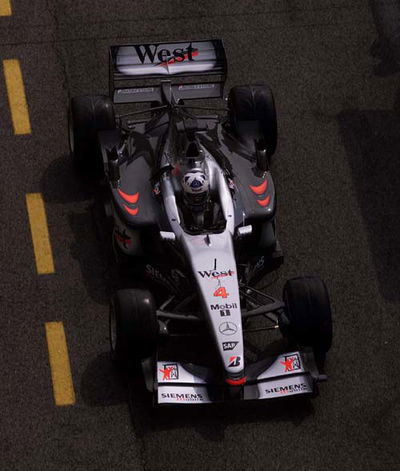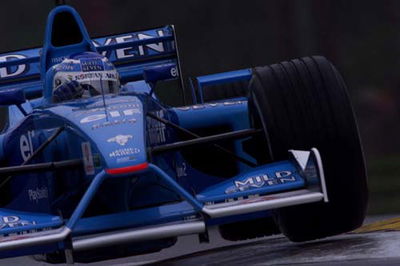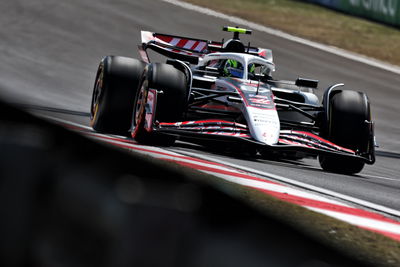McLaren's backroom engineers and their vital role.
F1 is not all glamour, fast cars and beautiful women. Back at the team's factories there is a host of engineers working long hours so the Michael Schumacher's and David Coulthard's of this world can have a successful race. Here courtesy of McLaren we focus on the backroom engineers back at Woking and the vital role they play...

F1 is not all glamour, fast cars and beautiful women. Back at the team's factories there is a host of engineers working long hours so the Michael Schumacher's and David Coulthard's of this world can have a successful race. Here courtesy of McLaren we focus on the backroom engineers back at Woking and the vital role they play...
"I think everyone who works in Formula 1 is an avid fan," said Matthew Jeffreys, McLaren International's Project Leader for chassis design. "Right from an early age it had me hooked." If you have never heard of Jeffreys, then that's no surprise as he is one of a vast group of men and women who work ceaselessly back at the team's Woking headquarters, far away from the media spotlight which shines on the race team.
"I joined the company in 1984 after I did my degree," says Jeffreys. "I was fortunate enough to do my industrial training with McLaren while doing my degree and when I graduated I stepped right into the job. It was a dream, because right from the age of 12, I had always wanted to work in F1. The chassis design group has responsibility for the monocoque, for the driver installation and controls and the front and rear wings. Breaking the work down into those groups, we can build a car in the shortest time possible. Within my group we have composites experts as well as mechanical engineering designers. Across the board we need various CAD skills as well, as the whole car is designed on CAD. The development of the car is a continuous process."
The new regulations for 2001 presented numerous challenges for Jeffreys and his team. "The whole design process starts with the aerodynamic shape of the car, so we are very much in the hands of the aerodynamic department," he explains. This means we cannot start our work on the monocoque which is my responsibility, until a decision is made about the aerodynamic package. During the winter it is an intense period, designing the car in a very short time and we are under extreme pressure to design, draw and feed the production department with our requirements."
Once the car is complete, it is time to move on. "We integrate with the race and test team by "handing over the baby" so to speak, having gone through its labour pains during the winter," says Jeffreys. "There is a handing over ceremony as they take it off our hands and we wave goodbye to it. It becomes part of you and every one is very motivated and emotional about their creation."
But the work goes on, long after the first car is built. "Wind tunnel continue their development work throughout the year and we introduce any improvements as and when required," continues Jeffreys. "In the few weeks after the first race of the season for example, we had a number of variations to the front and rear wings built and tested, as well as other aerodynamic aids, which we have found will produce an improvement. It is not uncommon for the car with which you finish a season to be 70% different to the one that started it."
"After a race or a test there is a wealth of info to be communicated back to the design department. These days, with E-mail, that can be done almost instantly. There is also the Monday morning Jobs List which arrives on our desk with numerous items which need attention and have a target date. This might be the next race or the next test or in three races time. No component gets forgotten about."
Mark Williams is an engineering manager on the test team and as such, is one of the first people to get his hands on the new car. "I put together the test programme and engineer the car at the test," he says. "I debrief the driver, look at the information we accumulate and decide which way to go forward. When the new car comes out you can see how it's going to perform. It's a very exciting time." This weekend's race in Spain has produced an additional challenge. "We've got some big changes for the Spanish Grand Prix with the introduction of traction control and all its associated toys, as we call them, so we have done a lot of work on that, as well as trying to improve the overall competitivity of the car," adds Williams.
In case you are not sure what is traction control, McLaren International's Managing Director, Martin Whitmarsh provides an explanation in layman's terms. "Traction control stops the rear wheels from spinning. In simple engineering terms it compares the speed of the rear wheels with the front wheels and if the rear wheels are turning quicker than the front then it reduces the power of the engine to stop them spinning unnecessarily."
David Coulthard does not believe the return of electronic aids will have much affect on the current grid. "Traction control will make very little difference to the grid.," maintains the current joint leader of the Drivers' Championship. "There will still be a difference between a good car and a bad car, even they use the same software."
But on the subject of engineers, be they at the factory, the test track or at a grand prix, Coulthard reckons they can make a big difference. "The engineers are very important. They translate what the driver feels, convert into technical speak and adjust the car accordingly. These cars are very complex. It's not a case of sticking a finger in the wind and making an adjustment to the front wing. It's all done by percentages and the engineer looks at all sorts of parameters like balance, either mechanical or aerodynamic, the wheel rates and the effect of tyre pressure on the springs and the contact patch of the tyres."
"The driver delivers the information and then waits for the engineer to come up with a magical fix. You build up a relationship with an engineer and you can develop a feeling, based on previous experience, but there are times when you rely completely on the engineer to work out the actual percentage balance change that is required."











